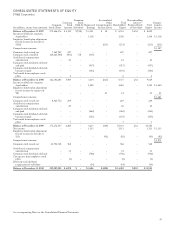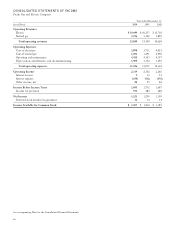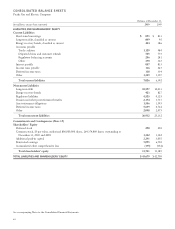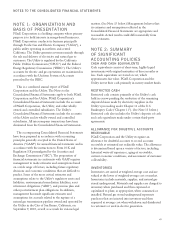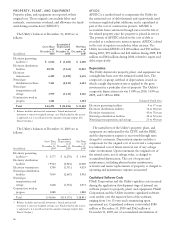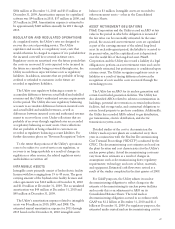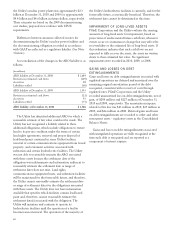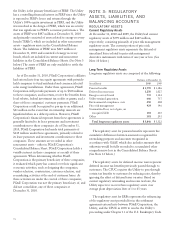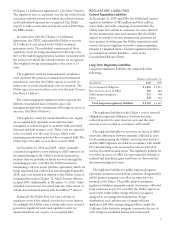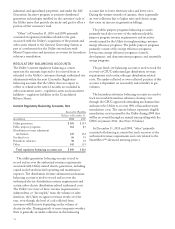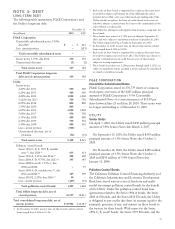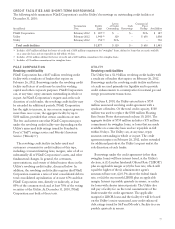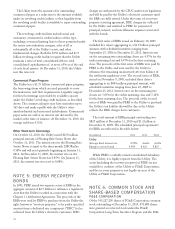PG&E 2010 Annual Report Download - page 73
Download and view the complete annual report
Please find page 73 of the 2010 PG&E annual report below. You can navigate through the pages in the report by either clicking on the pages listed below, or by using the keyword search tool below to find specific information within the annual report.
ACCUMULATED OTHER COMPREHENSIVE INCOME (LOSS)
Accumulated other comprehensive income (loss) reports a measure for accumulated changes in equity of an enterprise
that result from transactions and other economic events, other than transactions with shareholders. The following table
sets forth the after-tax changes in each component of accumulated other comprehensive income (loss):
Employee Benefit Plans – Accumulated Other Comprehensive
Income (Loss)
(in millions) 2010 2009 2008
Balance at beginning of year $ (160) $ (221) $ 10
Period change in pension benefits and other benefits:
Unrecognized prior service cost (1) (29) (1) 37
Unrecognized net gain (loss) (2) (110) 363 (1,583)
Unrecognized net transition obligation (3) 15 15 15
Transfer to regulatory account (4) (5) 82 (316) 1,300
Balance at end of year $ (202) $ (160) $ (221)
(1) Net of income tax benefit (expense) of $20 million, $1 million, and $(27) million for December 31, 2010, 2009, and 2008, respectively.
(2) Net of income tax benefit (expense) of $73 million, $(216) million, and $1,088 million for December 31, 2010, 2009, and 2008, respectively.
(3) Net of income tax benefit (expense) of $(11) million for December 31, 2010, 2009, and 2008.
(4) Net of income tax benefit (expense) of $(57) million, $218 million, and $(894) million for December 31, 2010, 2009, and 2008, respectively.
(5) Amounts transferred to the pension regulatory asset are probable of recovery from customers in future rates.
There was no material difference between PG&E
Corporation’s and the Utility’s accumulated other
comprehensive income (loss) for the periods presented
above.
REVENUE RECOGNITION
The Utility recognizes revenues after persuasive evidence
of an arrangement exists, delivery has occurred, or
services have been rendered; the price to the customer is
fixed or determinable; and collectability is reasonably
assured. Revenues meet these criteria as the electricity and
natural gas services are delivered, and include amounts for
services rendered but not yet billed at the end of the
period.
The Utility recognizes revenues after the CPUC or the
FERC has authorized rate recovery, amounts are
objectively determinable and probable of recovery, and
amounts will be collected within 24 months. (See Note 3
below.)
The CPUC authorizes most of the Utility’s revenue
requirements in its general rate case (“GRC”), which
generally occurs every three years. The Utility’s ability to
recover revenue requirements authorized by the CPUC in
the GRC does not depend on the volume of the Utility’s
sales of electricity and natural gas services. Generally, the
revenue recognition criteria are met ratably over the year.
The CPUC also has authorized the Utility to collect
additional revenue requirements to recover certain costs
that the Utility has been authorized to pass on to
customers, including costs to purchase electricity and
natural gas; to fund public purpose, demand response,
and customer energy efficiency programs; and to recover
certain capital expenditures. Generally, the revenue
recognition criteria for pass-through costs billed to
customers are met at the time the costs are incurred.
The Utility’s revenues and earnings also are affected by
incentive ratemaking mechanisms that adjust rates
depending on the extent the Utility meets certain
performance criteria. (See Note 15 below.)
The FERC authorizes the Utility’s revenue
requirements in annual transmission owner rate cases.
The Utility’s ability to recover revenue requirements
authorized by the FERC is dependent on the volume of
the Utility’s electricity sales, and revenue is recognized
only for amounts billed and unbilled.
In determining whether revenue transactions should be
presented net of the related expenses, the Utility considers
various factors, including whether the Utility takes title to
the product being delivered, has latitude in establishing
price for the product, and is subject to the customer
credit risk. In January 2001, the California Department of
Water Resources (“DWR”) began purchasing electricity to
meet the portion of demand of the California investor-
owned electric utilities that was not being satisfied from
the utilities’ own generation facilities and existing
electricity contracts. The Utility acts as a billing and
collection agent on behalf of the DWR and does not have
any authority to set prices for the energy delivered. The
69


